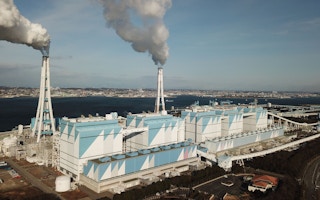The Glasgow Financial Alliance for Net Zero Asia Pacific (GFANZ APAC) network has kicked off a study to model the cost of decommissioning Japan’s coal-fired power plants early.
To continue reading, subscribe to Eco‑Business.
There's something for everyone. We offer a range of subscription plans.
- Access our stories and receive our Insights Weekly newsletter with the free EB Member plan.
- Unlock unlimited access to our content and archive with EB Circle.
- Publish your content with EB Premium.
The regional arm of GFANZ – a global coalition of insurers, banks and asset managers committed to reaching net-zero by 2050, that oversees a combined US$130 trillion of assets – published its finalised guidance for financing the managed phase-out of coal in Asia last December.
Speaking at the GFANZ APAC summit on Friday, Yuki Yasui, managing director of the regional network, said that as a next step, they will be working to apply the insights from the report to specific markets, starting with Japan.
The new research will explore the economic feasibility of phasing out coal-fired power plants in the context of Japan and its place in the country’s energy transition on the back of new financial innovations like “transition credits“, a novel class of carbon credits that the Singapore central bank has mooted as a way to sweeten the economic viability of energy transition projects.
“When Japan [previously] did a study on managed phase-out, they had ruled it out based on the economics of it, but things have obviously changed [with new financial mechanisms] and I think it’s the right time to revisit that,” said Yasui.
In addition to carbon credits, Ravi Menon, the former head of Monetary Authority of Singapore (MAS), who is also the chairmain of GFANZ APAC network’s advisory board, said that blended finance can be used to help lower the cost of capital for managed coal phase-outs and renewable energy development and crowd in private commercial capital.
Menon stressed the importance of shutting down the region’s largely young fleet of coal plants in the clean energy transition.
“If these coal plants are allowed to operate as planned, they will exhaust two-thirds of the remaining carbon budget to keep global temperature increase to within 1.5°C,” said Menon.
“It is not about divesting away from coal. It is about investing in the early phase-out of coal. It is about investing in renewable energy to replace the coal plants that are being decommissioned early so that communities continue to have access to electricity. It is about investing in energy storage and grid infrastructure to deal with the variability of renewable energy and lower its cost,” said Menon, who was recently appointed Singapore’s inaugural climate ambassador.
GFANZ APAC did not given a specific timeline for when they expect to publish the study’s results and which other specific markets they aim to look at.
No domestic discussions of coal phase-out yet
Yuri Okubo, senior researcher at Tokyo-based non-profit think tank Renewable Energy Institute (REI), welcomed the study on a managed coal phase-out in Japan.
“It would be a positive step to promote domestic discussions. So far, there have been no discussions of coal phase-out in Japan’s energy plan, although this is one of the primary problems being discussed in Southeast Asian countries, where Japan has invested in many coal-fired power projects,” Okubo told Eco-Business.
Okubo added that it is a particularly significant year for Japan since the country’s key energy policy, the Strategic Energy Plan – which is revised every three years – is up for a review this year.
Japan has committed to phasing out “inefficient” coal-fired power plants by the end of this decade and to replace them with “clean” coal power plants, employing nascent technologies like ammonia co-firing and carbon capture and storage (CCS), which the country plans to export to Southeast Asian nations.
In February, Japanese industry players Mitsui and Chugoku Electric Power inked a deal with Malaysia’s national oil and gas major Petronas to create a CCS value chain between the two countries, where Japan’s transported carbon will ultimately be buried in a depleted oil and gas field off the Malaysian coast.
Earlier this month, the country’s largest power generator JERA and engineering company IHI started the world’s first large-scale trial of combusting a mixture of coal and ammonia. JERA will start off with replacing 20 per cent of coal with ammonia – which does not emit carbon when burned – to produce the same amount of energy.
According to REI, while 20 per cent ammonia co-firing – which JERA aims make economically viable within the next few years – emits less carbon compared to coal-fired power plants, it emits twice as much carbon as natural gas-fired power plants. The technology also costs two to three times more than solar power, which is already cheaper than coal power in Asia.
Japan has initiated approximately 100 feasibility projects involving over 60 Japanese companies, with at least 30 projects announced in Southeast Asia.
Critics, including REI, worry that Japan’s promotion of such unproven and costly technologies will only serve to prolong the lifetime of existing coal assets and lock in the region’s reliance on fossil fuels.
Despite the skepticism, the Japanese government considered ammonia co-firing a “transition technology” in its transition roadmap for the power sector released in 2022. That same year, a study group led by Japanese megabank Mitsubishi UFJ Financial, a GFANZ APAC member, also included the use of ammonia at coal power plants on a list of transition technologies that financial institutions in the region can consider financing.










